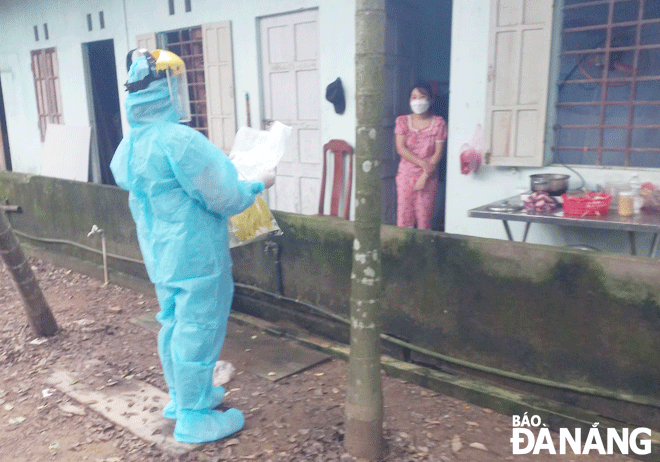Da Nang steps up to treat patients with mild COVID-19 symptoms at home
The COVID-19 pandemic requires careful management of hospital admissions in a bid to reduce the pressure on local health system while facing limitations in resources. Therefore, Da Nang is stepping up its programme to allow at-home treatment for patients with mild COVID-19 symptoms as its healthcare system is at risk of being “overwhelmed” by surging coronavirus infections.
 |
| A healthcare worker is giving medical advice on how to recover at home to a COVID-19 patient in Hoa Vang District. Photo: PHAN CHUNG |
Son Tra District recorded more than 1,600 cases of COVID-19 in just one week. With a surge in cases, Son Tra District has accelerated its home monitoring program for patients who have no symptoms or mild symptoms to help them recover from the illness.
As of January 17, there had been 621 asymptomatic patients and 80 patients with mild symptoms who are eligible for home isolation and care to recover from the illness in Son Tra District. Nai Hien Dong Ward has registered maximum cases in the district with 278 confirmed cases in a single week.
Doctor Nguyen Van Thuyen, the Deputy Director of the Son Tra District Medical Centre said that the district has been selected to pilot the city’s home isolation and care programme for COVID-19 patients with no symptoms or mild symptoms, thereby finding it very easy to deploy the program at large scale. The district has enjoyed strong public support for at-home care and treatment for patients with mild COVID-19 symptoms.
Doctor Tran Thanh Thuy, the Acting Director of the municipal Department of Health, warned that hospitals in Da Nang could soon be overwhelmed by COVID-19 amid a spike in cases. It is very important for Da Nang to promote monitoring and care of patients with mild COVID-19 symptoms at home amid the complex developments of the pandemic. Mrs Thuy stated that up to 99% of Da Nang’s COVID-19 patients are experiencing mild symptoms or no symptoms, and they are eligible for monitoring and care at home.
Mrs Thuy remarked that high priority is being given to protecting vulnerable and at-risk populations referring to older adults, those with underlying health conditions, and unvaccinated children. Data published by the health agency shows that 315 hospitalized patients in Da Nang have yet to receive a single jab, and among them are 226 children under the age of 12.
Mrs Thuy emphasized that the home isolation program for patients who have mild or no symptoms aims to lower patient load in hospitals. In addition, the program will help mildly ill COVID-19 patients to feel comfortable while in quarantine to recover at home.
Such patients are required to stay in a separate room away from other people in their homes and ensure it is well-ventilated and ideally has a window they can open. In addition, they must comply with COVID-19 guidelines, especially the 5K recommendations of the Ministry of Health, during their home quarantine period.
The patients must stay at home at all times and not have contact with other people in their family and their pets. This will help reduce the risk of spreading COVID-19 to other members of their family, especially seniors, those with underlying health conditions, and chiddren.
COVID-19 patients who are older adults aged over 65 years old or babies at three months of age or younger, those aged 50 to 64 vaccinated with just one dose, pregnant women, mothers after birth up to 6 weeks (42 days), along with those presenting an oxygen peripheral saturation (SpO2) between 94% and 96% are eligible for hospital admissions. In addition, patients requiring emergency care, those with underlying health conditions, and people with moderate to severe COVID-19 will be admitted to hospital for treatment.
For other special cases, staff of medical stations at ward, commune and district level will consult with their colleagues in the Da Nang General Hospital, the Lung Hospital, and the Hoa Vang District Medical Center to decide to transfer them to a healthcare facility for treatment.
Patients not presenting the above-mentioned criteria remain in their home with an intensive monitoring protocol.
Reporting by PHAN CHUNG – Translating by H.L